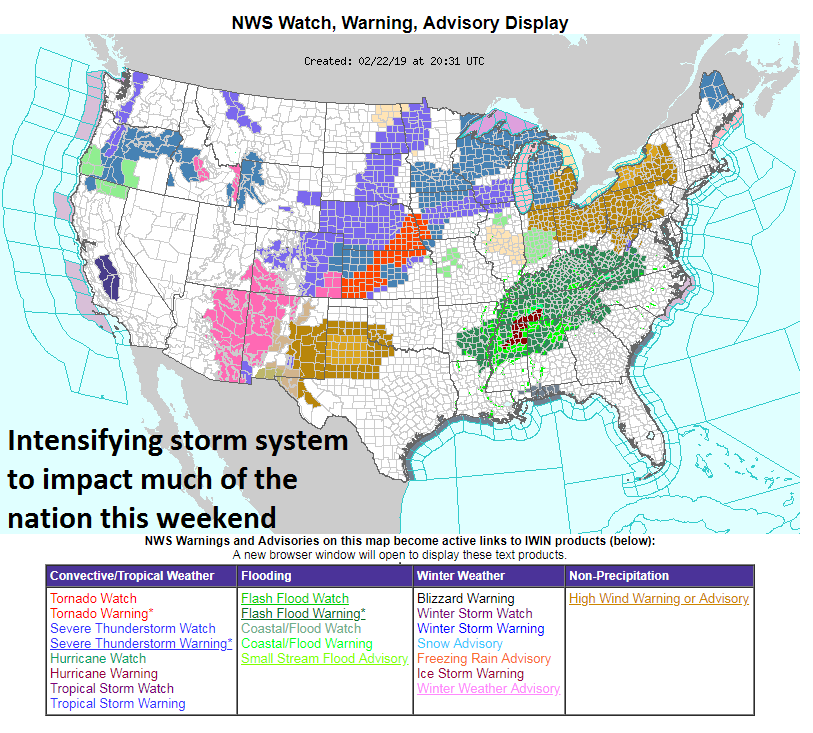11:45 AM | ***Explosive intensification of low pressure this weekend to have major ramifications including a blizzard in the Great Lakes and potentially damaging wind gusts in the Mid-Atlantic***
Paul Dorian
NOAA watches and warnings extend across much of the nation with snow-related threats extending from the Southwest US to the Great Lakes including blizzard warnings, flash flood threats in the Lower Mississippi and Tennessee Valleys, and high wind watches in the Ohio Valley and interior Mid-Atlantic. map courtesy NOAA
Overview
A storm that has already been a news making event in the Southwest US for its unusual snowfall will undergo explosive intensification this weekend and continue to make news as it’ll have major ramifications across much of the rest of the nation. Low pressure will pull out of the Southwest US early Saturday and begin to rapidly intensify as it starts a push to the northeast and towards the Great Lakes region where it will become an all-out blizzard. This system has the potential to strengthen over a 36-hour period from around 995 millibars (29.38 inches) early Saturday morning to near 973 millibars (28.73 inches) by late Sunday and it can ultimately result in monthly record low pressure readings in the Great Lakes region.
This is the time period in which rapid intensification will begin for the low pressure system near the Oklahoma Panhandle; map courtesy NOAA/EMC, tropicaltidbits.com
Discussion
Low pressure will pull out of the Southwest US late tonight and move to a position near the Oklahoma Panhandle by early Saturday morning with a central pressure around 995 millibars (29.38 inches). This system has already been a news making event in the Southwest US as it has produced snow in many unusual low-elevation locations including the Los Angeles metro region (e.g., Pasadena, West Hollywood) and Las Vegas, Nevada where measurable snow actually occurred two days in a row. In addition, some higher elevation locations that are more used to the snowfall had incredible amounts including Flagstaff, Arizona which endured its snowiest calendar day event ever with 35.9 inches of snow on Thursday.
Powerful storm over southeastern Canada by early Sunday evening with a very tight pressure gradient across the Upper Midwest/Great Lakes; map courtesy NOAA/EMC, tropicaltidbits.com
As very strong upper-level energy moves on top of the surface low pressure system on Saturday morning, explosive intensification will begin. The upper-level low will take on a “negatively-tilted” trough axis orientation (i.e., northwest-to-southeast) and this will enable strong upward motion in the vicinity which will lead to rapid intensification of the surface low as it begins a push northeastward and towards the Great Lakes. Very warm and humid air on the southeast flank (warm sector) of the developing storm will flow northward into the Lower Mississippi and Tennessee Valley. This will result in an enhanced severe weather threat including possible tornadoes for Arkansas, Louisiana and Mississippi. In addition, heavy rainfall over the Tennessee Valley on top of already well-saturated grounds will result in serious flash flooding concerns.
This is the time period in which rapid intensification will begin for the low pressure system near the Oklahoma Panhandle as deep upper-level energy moves overhead; map courtesy NOAA/EMC, tropicaltidbits.com
By Sunday morning, a powerful surface low pressure system with a central pressure near 980 millibars (28.94 inches) will be situated near Upper Michigan and its intensification will not be over. In fact, the powerful storm will likely deepen to around 973 millibars (28.73 inches) by Sunday evening as it treks into southern Canada. The difference in pressure between this major storm and strong high pressure over the Northern Plains will create a very tight pressure gradient and potential damaging wind gusts for the Great Lakes/Upper Midwest to go along with heavy snowfall in areas to the north and west of the surface low (e.g., Minnesota, Wisconsin, Iowa, Upper Michigan).
Heavy rainfall this weekend over the Lower Mississippi and Tennessee Valleys (circled) will lead to localized flooding concerns; map courtesy NOAA/EMC, tropicaltidbits.com
In the Mid-Atlantic region, this rapidly intensifying storm system will also have some important impacts. Rain is likely to overspread the I-95 corridor late tomorrow or early tomorrow night and then turn into a soaking rain event in the overnight hours with a rumble or two of thunder possible. The rain will begin with quite chilly conditions and temperatures primarily in the 40’s, but temperatures could rise late tomorrow night as milder air starts to push northward along the eastern seaboard. The rain will wind down in the DC-to-Philly-to-NYC corridor by mid-day on Sunday and the afternoon will feature increasingly strong winds and a spring tease as temperatures could spike to 60+ degrees. This warm up will be short-lived, however, and the winds will continue to intensify on Sunday night as a cold front sweeps through the region. There is the potential for wind gusts from Sunday night into mid-day Monday to reach the 50-60 mph range and this could certainly raise the chances for power outages in the Mid-Atlantic region; especially, given the well saturated grounds which can weaken root systems. The air mass itself that follows the cold frontal passage into the eastern US will be seasonably cold, but the powerful winds will, of course, make it feel much colder.
Meteorologist Paul Dorian
Perspecta, Inc.
perspectaweather.com
Video discussion:





